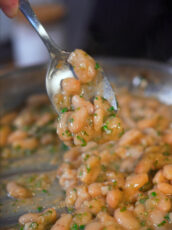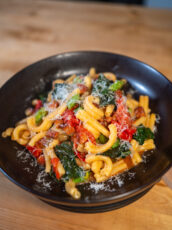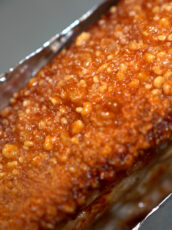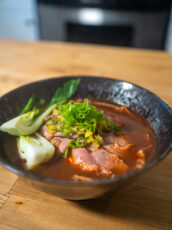Crispy Cantonese Roast Pork Belly, or Siu Yuk, is a dish that commands attention. The signature blistered, golden skin shatters like glass with each bite, giving way to layers of succulent meat and luscious pork fat. It’s a staple at Chinese BBQ shops, family feasts, and especially Lunar New Year celebrations.
I grew up eating Siu Yuk every year during Lunar New Year. Some of my earliest food memories are helping my mom poke holes into the pork skin while she juggled several dishes at once. Even now, after dozens of attempts, I wouldn’t call myself a master — because this dish is deceptively simple but filled with little nuances that make all the difference.
Whether you’re using an oven or air fryer, nailing the right technique is everything. In this post, I’ll walk you through my mom’s traditional oven method, share tips for success, and even touch on a hybrid approach using the air fryer for crispy skin perfection.
🔑 Tips for the Perfect Cantonese Roast Pork Belly
Making Siu Yuk at home might seem intimidating, but once you understand the key variables, you’ll be well on your way to achieving that signature crispy skin and flavorful meat. Here’s what to keep in mind at every step:
1. Choose the Right Cut of Pork Belly
Look for a pork belly slab that’s around 5 cm (2 inches) thick with even layers of meat and fat. The ideal cut has about five visible layers — known in Cantonese as ng fa yuk or “five-flower meat.” This balance ensures the meat stays juicy while the fat renders and keeps things tender.
2. Always Blanch Before Roasting
Blanching the pork belly in boiling water for 5–8 minutes helps tighten the skin, soften surface fat, and remove unpleasant odors from the meat. It also makes the skin easier to scrape and puncture later.
3. Poke the Skin Thoroughly — But Carefully
Use a skewer, meat tenderizer, or fork to poke hundreds of tiny holes across the skin. These holes allow air and moisture to escape, creating puffed-up, crackly skin. Be careful not to pierce into the meat, or juices may bubble up and soften the skin during roasting.
4. Score the Meat and Season Deeply
Scoring the meat side helps it cook evenly and allows seasoning to infuse the pork. A mix of hoisin, Shaoxing wine, salt, five-spice, and garlic powder adds savory-sweet complexity typical of Cantonese roast meats.
5. Dry the Skin Overnight (Uncovered!)
This is arguably the most critical step. Drying the skin in the fridge overnight dehydrates it, setting you up for the crispiest possible finish. For extra effect, brush the skin with vinegar before refrigerating.
6. Use a Salt Crust to Draw Out Moisture
During the first roast, covering the skin with a salt and egg white crust helps draw out even more moisture. It also protects the skin as the meat cooks.
7. Finish with High Heat for Maximum Crisp
Cranking the heat to 450°F (225°C) with a convection fan (if available) causes the dry skin to puff and blister dramatically. Keep a close eye during this stage — the line between perfect crisp and burnt skin is thin.
8. Let It Rest Before Slicing
Resting the pork belly for at least 20 minutes after roasting ensures the juices stay in the meat. Slice too soon, and all that flavor runs out.
How to Make Cantonese Roast Pork Belly (Siu Yuk)
🛒 Ingredients
For the Pork:
- 1 kg pork belly
- 1 tbsp hoisin sauce
- 1 tbsp Shaoxing wine
- Rice vinegar, for brushing
- Kosher salt (for covering the skin)
- 1 egg white
Spice Mix:
- 2 tsp kosher salt
- 1 tsp five-spice powder
- 1 tsp garlic powder
- 1 tsp white pepper
- 1 tsp sugar
🧑🍳 Traditional Oven Method (Step-by-Step)
Step 1: Blanch the Pork Belly
Boil a large pot of water and blanch the pork belly for 5–8 minutes. This helps purify the meat, tightens the skin, and removes any unwanted odor. Transfer it to an ice water bath for 5 minutes to halt the cooking and firm up the skin.
Optional: Use a knife to gently scrape the skin to remove any leftover hairs or gunk.

Step 2: Dry and Puncture the Skin
Pat the pork belly completely dry with paper towels. Then, using a skewer or meat tenderizer, poke tiny holes all over the skin, aiming just into the fat layer. This sets the stage for that signature bubbly skin.

Step 3: Score and Season the Meat
Flip the pork and score the meat side with 2 cm deep cuts in a crosshatch pattern. Brush with a mixture of hoisin sauce and Shaoxing wine, then rub in the spice mix thoroughly.

Step 4: Dry the Skin Overnight
Build a foil “basket” around the pork belly to support its shape and keep the skin facing up. Brush 1–2 teaspoons of rice vinegar over the skin. Refrigerate, uncovered, for at least 8 hours, preferably overnight. The skin should feel hard and dry by the next day.

Step 5: Roast with Salt Crust
Preheat your oven to 375°F (190°C). Mix 1 egg white with 1 cup of kosher salt to form a spreadable paste. Cover the pork skin with this crust and roast for 25–35 minutes, depending on the pork’s thickness.

Step 6: Final Roast for Crispy Skin
Remove the salt crust and increase oven temperature to 450°F (225°C). If your oven has a fan, use it. Roast for another 30 minutes, checking every 10 minutes to ensure the skin crisps evenly without burning.

Step 7: Rest and Slice
Let the pork belly rest for 20 minutes before slicing into it. The juices will settle, and you’ll be rewarded with perfectly crisp skin and juicy, flavorful meat.
🔥 Air Fryer vs. Traditional Oven: Which Method Wins?
The air fryer method is a fantastic shortcut. It’s fast, reliable, and produces a surprisingly crispy skin — even without an overnight dry. However, the skin may not blister as dramatically, and the meat won’t be as deeply flavored unless you prep it the same way.
The traditional oven method takes longer, but the results are unmatched. The flavors are bold, the skin is audibly crisp, and it’s worth the extra effort — especially for special occasions.💡
Pro Tip: Combine the two! Do all the prep steps from the traditional method, then use the air fryer for the final roast. The strong, circulating heat crisps the skin perfectly — just make sure your pork belly fits in the basket.
🍚 Serving Suggestions
Pair your crispy pork belly with:
- Steamed jasmine or sticky rice
- Stir-fried greens (like gai lan or bok choy)
- Hoisin or Chinese mustard dipping sauce
- Mantou buns or rice noodles for fusion twists
Final Thoughts
Cantonese roast pork belly is more than just a dish — it’s tradition, patience, and flavor layered into one beautiful slab of meat. Whether you follow my mom’s traditional oven method or shortcut it with an air fryer, remember that crispy skin comes from dry skin, proper poking, and high heat.
Once you nail those fundamentals, you’ll be well on your way to mastering one of Cantonese cuisine’s most iconic recipes.








